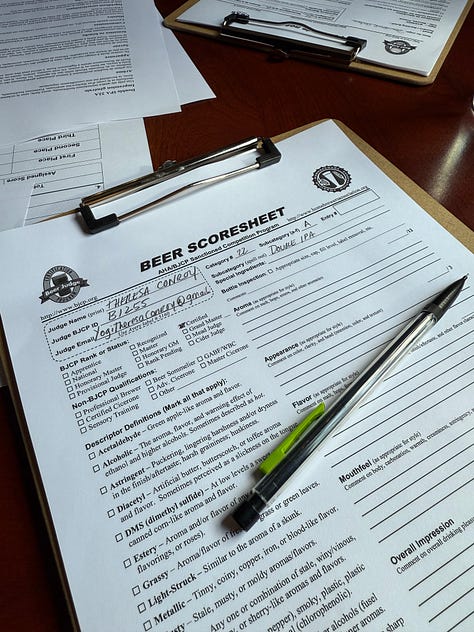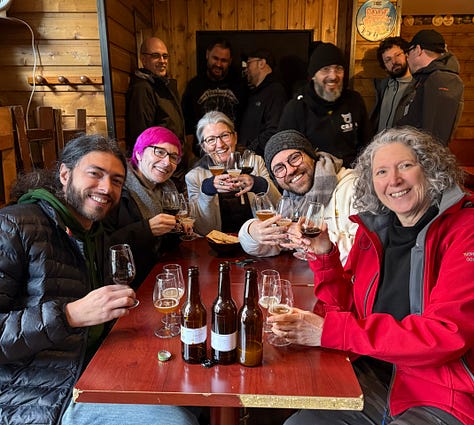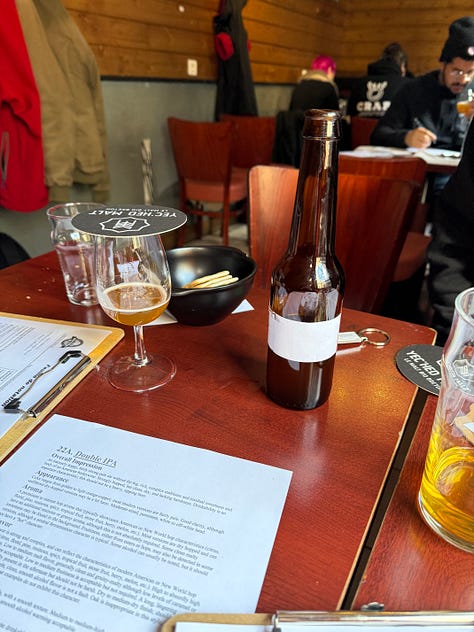I’m sitting with a Brazilian guy, two French women and a man from Italy. In front of each of us are three very different beers: a Double IPA, an Imperial Stout and a Catharina Sour. The task ahead is to choose the winner of the Saint-Malo Craft Beer Expo’s homebrewing competition.
My colleagues might have seemed as disparate as the brews, but we had the important stuff in common. We all were Certified Beer Judges, we all spoke English, and we all thought the Imperial Stout with piment d’espelette should win.
Last weekend I completed my first French beer competition. For those unfamiliar with some of my lesser-known credentials – which also include Private Investigator and guest on the Montel Williams Show – I acquired this one nearly 10 years ago, after I was trained and tested by the Beer Judge Certification Program (BJCP).
If you’re thinking, “Mmm, beer!” I need to break it to you: it’s not what you imagine. First, there’s actually much more smelling than drinking. Also, there’s a lot of chemistry involved. So much chemistry that I almost quit after my first class. So much chemistry that I cried a little bit on the way home. But I conquered it because beer judges must know the science of brewing so they can identify faults and advise homebrewers on how to avoid them.
In beer school, I learned the characteristics of more than 100 styles. It was an academic and experiential endeavor. Homework was fun, too, except for those couple times when Don insisted I learn how to brew my own beer, and it totally sucked. Even though I lacked beer-making skills, I easily passed BJCP’s online written test. The tasting exam was much more difficult, especially when the proctors purposely poured really bad homebrews.
According to the latest BJCP stats, I am one of 6,744 judges who have tasted 2,299,243 beers during 13,399 sanctioned amateur beer competitions. Add to that the 53 beers that 21 judges tasted during the Saint-Malo competition, organized by Collectif Rennais des amateur·rice·s de bières (CRAB), our local homebrew association.
The tasting was held at La Maison, a well-regarded craft beer bar near us, where my first assignment was to join a team of two terrific French guys. We settled around a wooden table covered with glasses, scoresheets and the bland crackers that cleanse our palates between sips. We were tasting DIPAs, a relief because that Catharina Sour – a new category from Brazil – scared me. The last time I judged sour beers was, not coincidentally, the last time I ever drank a sour beer.
Over the course of 2.5 hours we smelled, inspected and sipped seven hoppy entries, filling in score sheets with descriptions of the appearance, aroma, taste, mouthfeel and overall impression of the entry.
We were looking for faults. Faults in brewing include off-flavors, like cardboard, butter and canned corn. They are caused by errors like pitching the yeast at the wrong temperature, using dirty equipment or not allowing the fermentation process to finish. Faults also announce themselves in how the beer behaves. It may foam over, lack carbonation or look murky. With the number of things that can go wrong, it’s amazing that people end up making decent beer in their garages.
Don’t confuse beer judging with a wine-tasting tour in Sonoma. We don’t spit the beer out and we don’t use descriptors like opulent, structured, muscular or ironic. We lean toward “easy-drinking” or “funky.” We start by just looking at the beer, examining color, head, clarity. Then we smell, smell, smell. We cover the glass with a beer coaster, swirl it around a bit to release the scent, then take the coaster off and smell it again. At this point, I might take a tiny sip. Then I’m right back to sticking my nose in the glass.
All the smelling sometimes leads to nose blindness, so we take loud, deep sniffs of our sleeves to reset the nostrils for yet more smelling. Much more smelling.
The discussion begins after our individual scoresheets are complete. This is when we make the case to support our score – between 0 (problematic, to say the least) and 50 (world class example of style). Sometimes we agree and sometimes not. I’m a hard-line judge. If the beer veers even slightly away from the official style guide, I take off points. Others have a more generous approach. To settle things we come to a consensus and average our scores.
Obviously, we don’t do this to get buzzed. In fact, I usually can’t stomach the thought of beer for quite a while after judging (see: my ongoing distaste for sours), especially if I developed what we fondly refer to as, “Homebrew Belly,” which is exactly what you think it is.
Just like a dog show, the top contenders in each style compete against each other during a Mini Best of Show, what kennel clubs call Best in Breed. The winners of each beer style then compete against each other in the Best of Show.



Best of Show was what put me among that international group of judges, staring down one DIPA, one Catharina Sour and one Imperial Stout. It was like trying to choose among a chocolate cupcake, blackened tuna and sauerkraut. All those wildly-different flavors require wading in deep enough to select the one that, beneath the bite of hops or the sweetness of added fruit, is the most well crafted. It was, beyond a doubt, Mériadeg Kergadallan’s Imperial Stout.
Until last weekend, the only other beer competition that took me this far out of my comfort zone was my very first. I was confident about my skills and knowledge, but I still walked into that bar in Rennes nervous about being an outsider in this highly-specialized community. I wondered if I would be too old, too female, too American to fit in. To prepare, I spent some time reviewing style notes on my BJCP app and looking up descriptive French vocabulary words – like phenolic, acetaldehyde and skunky – that don’t come up in my everyday life.
My concerns were unwarranted. The event was convivial and the other judges were skilled and welcoming. It was all so very familiar, and also, well, foreign: the best qualities of a US beer competition with an international flavor. It reminded me that living in Europe provides a perfect opportunity to gather with people who speak different languages but still bond over the smell of malt and the tingle of an Imperial Stout spiked with pepper.
The very next day I signed up to judge a smoked beer competition in Germany.






How fun!
Sounds like fun. I prefer to drink it though.